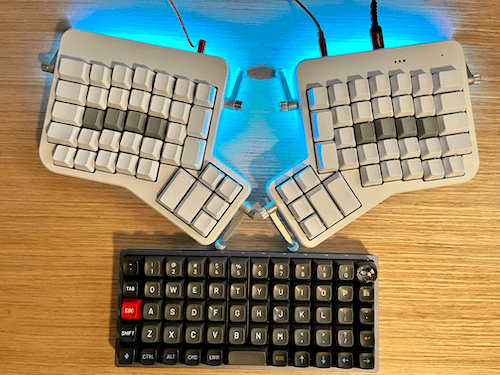- Published on
The Ergodox EZ Mechanical Keyboard
I have a certain love for mechanical keyboards. It's another one of those things that go hand-in-hand with developers who love coffee. My keyboard journey probably started in 2018 when I started developing for a living, what a coincidence! Now I must admit that I'm also one of those people who love shiny new gadgets, so why wouldn't I love cool mechanical keyboards.
The traditional keyboard has a staggered QWERTY layout and I often times find myself tilting my wrist or over-extending my fingers just to reach certain keys. Over time, it puts a lot of wear on my hands and soreness in my wrists. I am a touch typist with probably slightly smaller than average hands. The ergodox keyboard with it's two-piece ensemble means that I can move and tilt the keyboard independently for each hand. The ortholinear layout (QWERTY keys are not staggered like on traditional keyboards, they are in a line) also further reduces the amount of tilt/flex in my wrist when I have to move my fingers to different rows.
ErgoDox EZ
The ErgoDox EZ is an ergodox keyboard made more user-friendly. Typically, an ergodox keyboard refers to the two-piece ergonomic keyboard which are available as a DIY project. You would not only need to build the keyboard but also have to program and flash (put the program onto the keyboard circuit board). The ErgoDox comes assembled but still has a lot of customizable features like key switches, color, and keycaps you can choose from.
21 Questions
Not really 21, but you get the idea.
What is the difference between ergodox and ErgoDox EZ?
Ergodox refers to the two-piece keyboard design while ErgoDox EZ is a branded, type of ergodox.
What I love about it
- The split keyboard design and having 76 keys up front.
- It's super easy to program via their online flashing interface and Wally app.
- Being able to have layers for other keymaps (most programmable keyboards offer this feature).
What I don't care for about it
- It is a bit too big for my hands.
- I think most of the keys on the thumb cluster I don't us or tend to forget what is mapped to them.
- The blank keycaps.
What the heck are layers?
Look at your keyboard with printed keys, now image that underneath those keys theres another set of keys with different operations, waiting to be pressed. That's essentially a lower layer. When you press a layer toggle key, your whole top level keys changes into lower level keys, allowing you to get double the amount of options.
My go to setup is 3 layers:
- Layer 1 (top layer) with QWERTY, the most used keys.
- Next layer with symbols, for example I have open and close parantheses on different sides but mapped to the same finger (this helps my programming dramatically, I don't need to use my pinky for all the symbols now).
- Last layer lies the numbers and misc (I map out a numpad on the right hand side and some media functions on the left).
Check out my custom keymap setup.
Why did you pick blank keycaps?
Because of how custom you can make this keyboard, printed keycaps only come in alphanumeric of the same profile. I opted for the blank caps because they have sculpted DCS profiles (meaning the shape of the top of the key caps are angled differently specific for each row).
My initial thought was that it wouldn't matter if I had alphanumeric because I can touch type... also, if I have layers, the keys would be different a lot of the times anyways. But using it for some time, its still nice to have the numbers on the top row and maybe some arrow keys.
What other customizations did you do?
I replaced all of the original Cherry MX Brown switches with a combination of Holy Pandas and Zilents for max tactile feels. Quite honestly, I didn't have enough Holy Pandas to fill the board (a good amount are still on my Preonic board).
Do you love it more than the Preonic?
This is a hard question to answer... I am deeply in love with the Preonic keyboard, mostly because I barely have any finger stretch/reach problems, I don't need to float the keyboard, my hands stay put. 59 keys is a few less that I'd like though... due to my layout/layer style, it's quite hard to remember some of the more robust key combinations, I'll admit.
I wish the Ergodox EZ came with a metal base, Holy Pandas just don't sound as good on plastic.
Show me some the goods!

On the top is the Ergodox EZ. On the bottom is the Preonic from Drop.